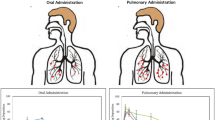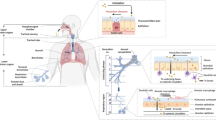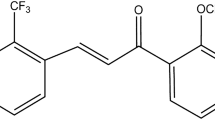ABSTRACT
Purpose
Novel itraconazole (ITZ)-based dry powders for inhalation (DPI) were optimized for aerodynamic and dissolution properties and contained excipients that are acceptable for inhalation.
Methods
The DPI were produced by spray drying solutions. The drug content, crystallinity state, and morphological evaluation of the dry powders were determined by high performance liquid chromatography, powder X-ray diffraction, differential scanning calorimetry, and scanning electron microscopy, respectively. A particle size analysis was conducted using laser light scattering. The aerodynamic behaviors of the powders were characterized by impaction tests. ITZ dissolution rates were evaluated using a dissolution method adapted to inhaled products.
Results
The DPI presented very high fine particle fractions that ranged from 46.9% to 67.0% of the nominal dose. The formulations showed very fast dissolution rates compared to unformulated crystalline ITZ with the possibility of modulating the dissolution rate by varying the quantity of phospholipids (PL) incorporated. ITZ remained amorphous while the mannitol was crystalline. The α, β and δ-mannitol polymorph ratios varied depending on the formulation compositions.
Conclusion
This formulation strategy could be an attractive alternative for treating invasive pulmonary aspergillosis. The ITZ and PL content are key characteristics because of their influence on the dissolution rate and aerosol performance.








Similar content being viewed by others
Abbreviations
- API:
-
active pharmaceutical ingredient
- CI:
-
Carr’s index
- dae :
-
aerodynamic diameter
- DPI(s):
-
dry powder(s) for inhalation
- ED:
-
emitted dose
- FDA:
-
Food and Drug Administration
- FPD:
-
fine particle dose
- FPF:
-
fine particle fraction
- IA:
-
invasive aspergillosis
- IC:
-
immunocompromised
- ICDD:
-
International Center for Diffraction Data
- ITZ:
-
itraconazole
- IV:
-
intravenous
- MIC:
-
minimal inhibitory concentration
- MsLI:
-
multi-stage liquid impactor
- MTDSC:
-
modulated temperature differential scanning calorimetry
- NGI:
-
next generation impactor
- PL:
-
phospholipids
- PSD:
-
particle size distribution
- PXRD:
-
powder X-ray diffraction
- RIR:
-
reference intensity ratio
- RPM:
-
round per minute
- SD:
-
spray dried
- SEM:
-
scanning electron microscopy
- TGA:
-
thermogravimetric analysis
References
Mcneil MM, Nash SL, Hajjeh RA, Phelan MA, Conn LA, Plikaytis BD, Warnock DW. Trends in mortality due to invasive mycotic diseases in the United States, 1980–1997. Clin Infect Dis. 2001;33:641–7.
Denning DW. Invasive aspergillosis. Clin Infect Dis. 1998;26:781–803.
Hope WW. Invasion of the alveolar-capillary barrier by Aspergillus spp.: therapeutic and diagnostic implications for immunocompromised patients with invasive pulmonary aspergillosis. Med Mycol. 2009;47 Suppl 1:S291–8.
Hope WW, Billaud EM, Lestner J, Denning DW. Therapeutic drug monitoring for triazoles. Curr Opin Infect Dis. 2008;21:580–6.
Coronel B, Levron JC, Dorez D, Van Devenne A, Archimbaud E, Mercatello A. Itraconazole lung concentrations in haematological patients. Mycoses. 2000;43:125–7.
Hoeben BJ, Burgess DS, McConville JT, Najvar LK, Talbert RL, Peters JI, Wiederhold NP, Frei BL, Graybill JR, Bocanegra R, Overhoff KA, Sinswat P, Johnston KP, Williams RO. In vivo efficacy of aerosolized nanostructured itraconazole formulations for prevention of invasive pulmonary aspergillosis. Antimicrob Agents Chemother. 2006;50:1552–4.
Alvarez CA, Wiederhold NP, McConville JT, Peters JI, Najvar LK, Graybill JR, Coalson JJ, Talbert RL, Burgess DS, Bocanegra R, Johnston KP, Williams RO. Aerosolized nanostructured itraconazole as prophylaxis against invasive pulmonary aspergillosis. J Infect. 2007;55:68–74.
Chan HK. Dry powder aerosol delivery systems: current and future research directions. J Aerosol Med. 2006;19:21–7.
Amidon GL, Lennernas H, Shah VP, Crison JR. A theoretical basis for A biopharmaceutic drug classification—the correlation of in-vitro drug product dissolution and in-vivo bioavailability. Pharm Res. 1995;12:413–20.
Yang W, Tam J, Miller DA, Zhou J, McConville JT, Johnston KP, Williams RO. High bioavailability from nebulized itraconazole nanoparticle dispersions with biocompatible stabilizers. Int J Pharm. 2008;361:177–88.
Tran CL, Buchanan D, Cullen RT, Searl A, Jones AD, Donaldson K. Inhalation of poorly soluble particles. II. Influence of particle surface area on inflammation and clearance. Inhal Toxicol. 2000;12:1113–26.
Jones RM, Neef N. Interpretation and prediction of inhaled drug particle accumulation in the lung and its associated toxicity. Xenobiotica. 2012;42:86–93.
Bindu MB, Kusum B, Banji D. Novel strategies for poorly water soluble drugs. Int J Pharm Sci Rev Res. 2010;4:76–84.
Pilcer G, Amighi K. Formulation strategy and use of excipients in pulmonary drug delivery. Int J Pharm. 2010;392:1–19.
Duret C, Wauthoz N, Sebti T, Vanderbist F, Amighi K. Solid dispersions of itraconazole for inhalation with enhanced dissolution, solubility and dispersion properties. Int J Pharm. 2012;428(1–2):103–13.
Weers JG, Tarara TE, Clark AR. Design of fine particles for pulmonary drug delivery. Expert Opin Drug Deliv. 2007;4(3):297–313.
Shah B, Kakumanu VK, Bansal AK. Analytical techniques for quantification of amorphous/crystalline phases in pharmaceutical solids. J Pharm Sci. 2006;95:1641–65.
Chung FH. Quantitative interpretation of X-ray diffraction patterns of mixtures. II. Adiabatic principle of X-ray diffraction analysis of mixtures. J App Cryst. 1974;7:526–31.
Wandt MA, Rodgers AL. Quantitative X-ray diffraction analysis of urinary calculi by use of the internal-standard method and reference intensity ratios. Clin Chem. 1988;34:289–93.
Galunin E, Vidal M, Alba MD. The effect of polymorphic structure on the structural and chemical stability of yttrium disilicates. Am Mineral. 2011;96:1512–20.
Morris G, Kokki MH, Anderson K, Richardson MD. Sampling of Aspergillus spores in air. J Hosp Infect. 2000;44:81–92.
Shah VP, Tsong Y, Sathe P, Liu JP. In vitro dissolution profile comparison–statistics and analysis of the similarity factor, f2. Pharm Res. 1998;15:889–96.
Weiler C, Egen M, Trunk M, Langguth P. Force control and powder dispersibility of spray dried particles for inhalation. J Pharm Sci. 2010;99:303–16.
Miao S, Roos YH. Crystallization kinetics and x-ray diffraction of crystals formed in amorphous lactose, trehalose, and lactose/trehalose mixtures. J Food Sci. 2005;70:E350–8.
Hulse WL, Forbes RT, Bonner MC, Getrost M. The characterization and comparison of spray-dried mannitol samples. Drug Dev Ind Pharm. 2009;35:712–8.
Elversson J, Millqvist-Fureby A. Particle size and density in spray drying—effects of carbohydrate properties. J Pharm Sci. 2005;94:2049–60.
Sebti T, Amighi K. Preparation and in vitro evaluation of lipidic carriers and fillers for inhalation. Eur J Pharm Biopharm. 2006;63:51–8.
Kaialy W, Martin GP, Ticehurst MD, Momin MN, Nokhodchi A. The enhanced aerosol performance of salbutamol from dry powders containing engineered mannitol as excipient. Int J Pharm. 2010;392:178–88.
Burger A, Henck JO, Hetz S, Rollinger JM, Weissnicht AA, Stottner H. Energy/temperature diagram and compression behavior of the polymorphs of D-mannitol. J Pharm Sci. 2000;89:457–68.
Hulse WL, Forbes RT, Bonner MC, Getrost M. Influence of protein on mannitol polymorphic form produced during co-spray drying. Int J Pharm. 2009;382:67–72.
Ostwald W. Studien uber die bildung und Umwandlung fester Korper. Z Phys Chem. 1897;22:289.
Khoshkhoo S, Anwart J. Crystallization of polymorphs: the effect of solvent. J Phys D: Appl Phys. 1993;26:890–3.
Yoshinari T, Forbes RT, York P, Kawashima Y. Moisture induced polymorphic transition of mannitol and its morphological transformation. Int J Pharm. 2002;247:69–77.
Alves GP, Santana MHA. Phospholipid dry powders produced by spray drying processing: structural, thermodynamic and physical properties. Powder Technol. 2004;145:139–48.
Iida K, Hayakawa Y, Okamoto H, Danjo K, Leuenberger H. Evaluation of flow properties of dry powder inhalation of salbutamol sulfate with lactose carrier. Chem Pharm Bull. 2001;49:1326–30.
Larhrib H, Martin GP, Marriott C, Prime D. The influence of carrier and drug morphology on drug delivery from dry powder formulations. Int J Pharm. 2003;257:283–96.
Zhang Y, Wang XL, Lin X, Liu XL, Tian B, Tang X. High azithromycin loading powders for inhalation and their in vivo evaluation in rats. Int J Pharm. 2010;395:205–14.
Bosquillon C, Rouxhet PG, Ahimou F, Simon D, Culot C, Preat V, Vanbever R. Aerosolization properties, surface composition and physical state of spray-dried protein powders. J Control Release. 2004;99:357–67.
Glasmacher A, Hahn C, Leutner C, Molitor E, Wardelmann E, Losem C, Sauerbruch T, Marklein G, Schmidt-Wolf IG. Breakthrough invasive fungal infections in neutropenic patients after prophylaxis with itraconazole. Mycoses. 1999;42:443–51.
Berenguer J, Ali NM, Allende MC, Lee J, Garrett K, Battaglia S, Piscitelli SC, Rinaldi MG, Pizzo PA, Walsh TJ. Itraconazole for experimental pulmonary aspergillosis: comparison with amphotericin B, interaction with cyclosporin A, and correlation between therapeutic response and itraconazole concentrations in plasma. Antimicrob Agents Chemother. 1994;38:1303–8.
Pfaller MA, Messer SA, Hollis RJ, Jones RN. Antifungal activities of posaconazole, ravuconazole, and voriconazole compared to those of itraconazole and amphotericin B against 239 clinical isolates of Aspergillus spp. and other filamentous fungi: Report from SENTRY Antimicrobial Surveillance Program, 2000. Antimicrob Agents Chemother. 2002;46:1032–7.
Osaki T, Hanagiri T, Nakanishi R, Yoshino I, Taga S, Yasumoto K. Bronchial arterial infusion is an effective therapeutic modality for centrally located early-stage lung cancer: results of a pilot study. Chest. 1999;115:1424–8.
Lee YY, Wu JX, Yang M, Young PM, van Den BF, Rantanen J. Particle size dependence of polymorphism in spray-dried mannitol. Eur J Pharm Sci. 2011;44:41–8.
Snelders E, van der Lee HA, Kuijpers J, Rijs AJ, Varga J, Samson RA, Mellado E, Donders AR, Melchers WJ, Verweij PE. Emergence of azole resistance in Aspergillus fumigatus and spread of a single resistance mechanism. PLoS Med. 2008;5:e219.
Mortensen KL, Johansen HK, Fuursted K, Knudsen JD, Gahrn-Hansen B, Jensen RH, Howard SJ, Arendrup MC. A prospective survey of Aspergillus spp. in respiratory tract samples: prevalence, clinical impact and antifungal susceptibility. Eur J Clin Microbiol Infect Dis. 2011;30:1355–63.
Verweij PE, Howard SJ, Melchers WJ, Denning DW. Azole-resistance in Aspergillus: proposed nomenclature and breakpoints. Drug Resist Updat. 2009;12:141–7.
Misra R, Malik A, Singhal S. Comparison of the activities of amphotericin B, itraconazole, and voriconazole against clinical and environmental isolates of Aspergillus species. Indian J Pathol Microbiol. 2011;54:112–6.
Wauthoz N, Deleuze P, Saumet A, Duret C, Kiss R, Amighi K. Temozolomide-based dry powder formulations for lung tumor-related inhalation treatment. Pharm Res. 2011;28:762–75.
Six K, Verreck G, Peeters J, Brewster M, Van den Mooter G. Increased physical stability and improved dissolution properties of itraconazole, a class II drug, by solid dispersions that combine fast- and slow-dissolving polymers. J Pharm Sci. 2004;93:124–31.
Author information
Authors and Affiliations
Corresponding author
Rights and permissions
About this article
Cite this article
Duret, C., Wauthoz, N., Sebti, T. et al. New Respirable and Fast Dissolving Itraconazole Dry Powder Composition for the Treatment of Invasive Pulmonary Aspergillosis. Pharm Res 29, 2845–2859 (2012). https://doi.org/10.1007/s11095-012-0779-4
Received:
Accepted:
Published:
Issue Date:
DOI: https://doi.org/10.1007/s11095-012-0779-4




